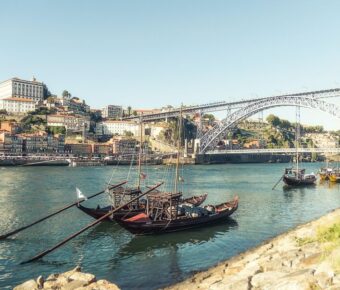
Siena vs San Gimignano: Which Enchanting Tuscan Town Should You Visit First?
Tuscany has two incredible medieval towns that capture travelers’ hearts: Siena and San Gimignano. These stunning hilltop destinations each offer their special magic, making it tough to pick between them.
Siena stands out as the better choice for travelers seeking a deeper dive into Tuscan culture, with its grand Piazza del Campo, rich history, and lively atmosphere, while San Gimignano works better as a shorter day trip for those wanting to see medieval towers and enjoy spectacular countryside views. The choice comes down to how much time you have.
San Gimignano packs plenty of charm into its small size, with its famous stone towers creating an unforgettable skyline. Siena spreads out more, offering hidden corners to explore and local life to soak in. Both places get busy with tourists, but each keeps its authentic Italian spirit alive through architecture, food, and traditions that have lasted centuries.
Table of Contents
- Historical Significance
- The Birth of Siena
- San Gimignano’s Towering Past
- Cultural Insights
- Artistic Legacy of Siena
- Folklore and Traditions in San Gimignano
- Architectural Highlights
- Siena’s Cathedral and Public Spaces
- Medieval Architecture of San Gimignano
- Culinary Experiences
- Siena’s Gastronomy
- Taste of San Gimignano
- Travel and Accessibility
- Getting to Siena
- Exploring San Gimignano
- Leisure and Shopping
- Retail Therapy in Siena
- Markets of San Gimignano
- Outdoor Activities
- Nature Around Siena
- Countryside Treks in San Gimignano
- Accommodation Options
- Staying in Siena
- Lodgings in San Gimignano
- Events and Festivals
- Siena’s Palio Horse Race
- Seasonal Events in San Gimignano
- Frequently Asked Questions
- What are the best transport options for traveling from Siena to San Gimignano?
- How much time should one allocate to visit San Gimignano effectively?
- Can a day trip from Florence include Siena and San Gimignano without feeling rushed?
- What unique experiences does Siena offer that differ from San Gimignano?
- When comparing Siena to San Gimignano, what are the key cultural and historical distinctions?
- Are there hidden gems in Siena or San Gimignano that a typical tour might not cover?
- Book Your Dream Experience
- More Travel Guides
Historical Significance
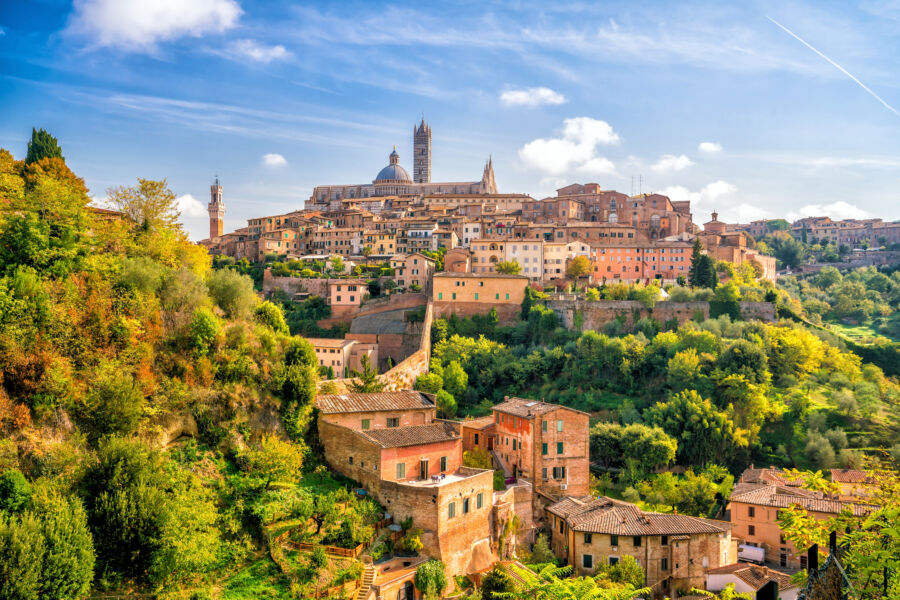
The medieval cities of Siena and San Gimignano showcase impressive architectural achievements and rich cultural heritage that shaped Tuscany’s identity. Both cities played vital roles in trade, banking, and art during Italy’s Middle Ages.
The Birth of Siena

Siena grew from a small Roman settlement into a powerful medieval banking center. Its wealth peaked in the 1200s and 1300s, rivaling Florence’s.
The famous Piazza del Campo emerged as the heart of civic life. This shell-shaped square hosted markets, festivals, and the thrilling Palio horse race that continues today.
Siena’s Gothic cathedral is a masterpiece of medieval architecture. Its black-and-white marble stripes make it instantly recognizable.
The city’s powerful banking families built magnificent palaces. These towering homes displayed their status, turning Siena’s skyline into an architectural wonder.
San Gimignano’s Towering Past

San Gimignano earned the nickname “Medieval Manhattan” for its stunning tower houses. Noble families built 72 towers in the 1300s to showcase their wealth and power.
Today, 14 towers still reach toward the sky. The Torre Grossa is the city’s highest point, standing 54 meters tall.
The town grew rich from saffron trade and its location on the pilgrim route to Rome. Merchants and travelers brought wealth and new ideas.
Medieval frescos cover the walls of its churches and public buildings. These colorful artworks tell stories of daily life, religion, and culture from centuries past.
The perfectly preserved walls and streets make visitors feel they’ve returned in time. Its medieval charm draws tourists from around the world.
Cultural Insights

Medieval Tuscany’s artistic and cultural heritage comes alive through the unique traditions and creative achievements preserved in these historic towns. Local customs and masterpieces tell stories of their rich past.
Artistic Legacy of Siena
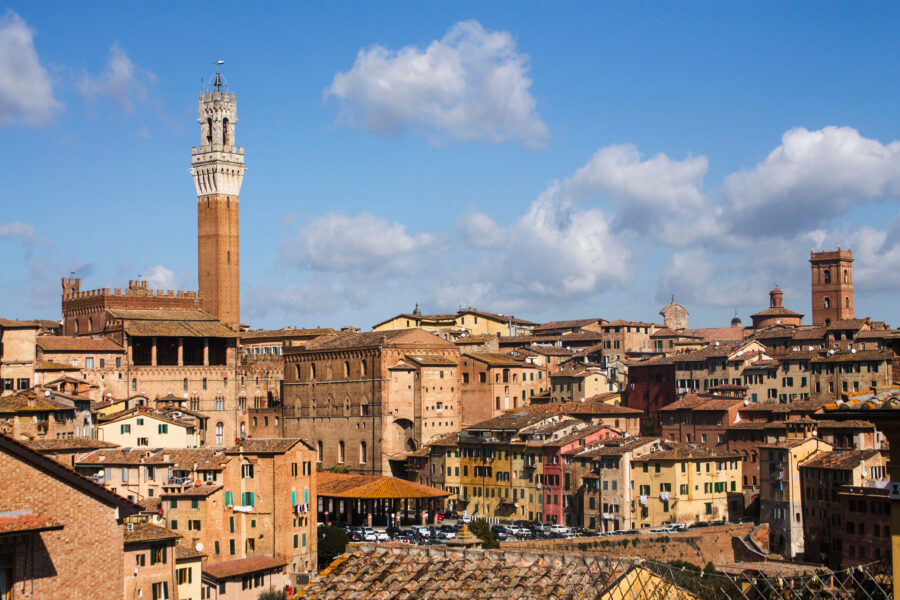
Siena’s artistic influence shines through its remarkable Gothic architecture and distinctive painting style. The Sienese School of painting developed its artistic identity in the 13th and 14th centuries, setting it apart from other Italian art movements.
The city’s artists favored rich colors and elegant figures, visible in masterpieces at the Pinacoteca Nazionale. Notable painters like Duccio and Simone Martini created works that influenced European art.
The Palio horse race tradition merges art with culture by creating elaborate banners. Tribal artists design these prized rappellings each year, representing the city’s 17 contra de (districts).
Folklore and Traditions in San Gimignano

San Gimignano’s medieval towers symbolize the town’s unique cultural practices. These towers weren’t just for defense – wealthy families built them as status symbols, creating a competitive tradition that shaped the town’s identity.
The town maintains strong ties to its farming heritage through vernaccia wine production. Local vintners still use traditional methods passed down through generations to create this distinct white wine.
Traditional festivals celebrate the town’s medieval roots. In June, the Fiera delle Messi recreates medieval life with period costumes, music, and demonstrations of ancient crafts.
Architectural Highlights

The architectural wonders of Siena and San Gimignano showcase two distinct styles of medieval Italian design. Each city features unique elements that have made it famous across Tuscany and beyond.
Siena’s Cathedral and Public Spaces

The striking Siena Cathedral stands out with its black and white marble stripes, making it one of Italy’s most eye-catching churches. Its facade sparkles with intricate sculptures, colorful mosaics, and detailed Gothic carvings that tell biblical stories.
Piazza del Campo forms the heart of Siena. This shell-shaped public square slopes gently downward, creating a natural amphitheater effect. The red-brick pavement divides the space into nine sections, representing the Council of Nine who once ruled the city.
The 102-meter Torre del Mangia looms above the square. Climbing its 400 steps rewards visitors with stunning city and surrounding countryside views. The tower’s height matches the cathedral’s exactly – a deliberate choice to show the equal power of church and state.
Medieval Architecture of San Gimignano

San Gimignano’s famous skyline features 14 tall stone towers that rise dramatically above the town. Once numbered 72, these tower houses were built by wealthy families competing to demonstrate their power and wealth.
The town’s medieval architecture remains remarkably intact. Piazza della Cisterna sits at the highest point, surrounded by well-preserved medieval buildings and ancient wells that once supplied water to residents.
San Gimignano’s narrow cobblestone streets wind between sturdy stone buildings. Many still feature their original architectural details, such as arched doorways, wooden shutters, and decorative window frames.
The town’s defensive walls and gates stand much as they did 800 years ago. Walking these ancient fortifications gives visitors an authentic glimpse into medieval life.
See Related: How Much Does a Europe Trip Cost: Budget-Savvy Guide for 2025
Culinary Experiences

Siena and San Gimignano offer distinct food cultures that showcase Tuscany’s rich culinary heritage through local specialties, wine traditions, and memorable dining experiences.
Siena’s Gastronomy

Siena takes pride in its traditional pici pasta—thick, hand-rolled noodles served with rich meat sauces or simple olive oil and pecorino cheese. The city’s butcher shops display the famous Chianina beef, perfect for the classic Tuscan bistecca alla Fiorentina.
The local bakeries fill their windows with panforte, a dense fruit and nut cake spiced with pepper and nutmeg. This medieval treat remains popular during holidays and festivals.
Siena’s trattorias serve hearty soups like ribollita, which are made with bread, beans, and seasonal vegetables. Many restaurants around Piazza del Campo pair these dishes with local Chianti wines.
Taste of San Gimignano

San Gimignano is famous for its award-winning Vernaccia di San Gimignano white wine, produced exclusively in the surrounding hillsides. Local wineries offer tastings paired with regional specialties.
The town’s signature flavors include golden saffron, which was once so valuable that it helped build San Gimignano’s famous towers. You’ll find it in risottos and pasta dishes throughout the medieval center today.
Gelateria Dondoli, twice named the world’s best gelato shop, creates unique flavors like saffron-pine nut and Vernaccia wine sorbet. Local food shops sell wild boar salami, truffles, and aged pecorino cheese.
The countryside around town hosts family-run farms where you can enjoy authentic farmhouse lunches featuring home-cured meats and fresh pasta.
Travel and Accessibility

Getting around both cities requires some planning, especially for visitors with mobility needs. The medieval streets and unique layouts create distinct travel experiences in each location.
Getting to Siena

Siena is about an hour south of Florence by car. The city can be tricky to navigate since cars aren’t allowed in the historic center. Several parking lots ring the outer walls, the most convenient of which is Il Campo.
Public buses run frequently from Florence to Siena. The trip takes around 75 minutes and drops you near the city center.
Many visitors choose guided tours that handle the transportation logistics. These often combine Siena with other Tuscan destinations in one day.
Exploring San Gimignano

San Gimignano’s compact size makes it easier to explore than Siena. The main streets are lined with cobblestones and can be steep in places.
Book a rental car to give yourself flexibility. Parking lots P1 and P2 offer the best access to the town center.
The streets have some hills and slanted sections that wheelchair users should note. Accessible paths connect most major attractions, though some medieval alleys may be too narrow for wheelchairs.
Tour companies offer specialized accessible vans and guides familiar with the best routes through town.
Leisure and Shopping

Shopping in these Tuscan towns brings distinct experiences. Siena offers elegant boutiques and artisan shops, while San Gimignano draws visitors with its local markets and specialty food stores.
Retail Therapy in Siena

The historic center of Siena sparkles with boutique shopping along Via Banchi di Sopra. This main shopping street features Italian fashion brands and leather goods shops selling handmade bags and shoes.
Local artisans craft beautiful ceramics and hand-painted pottery in tiny workshops scattered through the medieval streets. These unique pieces make perfect souvenirs.
The area around Piazza del Campo houses specialty food shops selling Tuscan treats like panforte and ricciarelli cookies. Wine shops offer tastings of local Chianti.
Markets of San Gimignano

The Thursday morning market in Piazza del Duomo brings locals and tourists together. Vendors sell fresh produce, cheeses, cured meats, and seasonal specialties.
Small family-run shops along Via San Giovanni specialize in the town’s famous saffron. Many offer free samples of saffron-flavored products.
The award-winning Gelateria Dondoli serves unique gelato flavors like saffron and blackberry lavender. Lines often stretch around the corner, but the wait is worth it.
Specialty wine shops focus on the local Vernaccia di San Gimignano white wine. Many offer tastings paired with local cheeses and meats.
Outdoor Activities
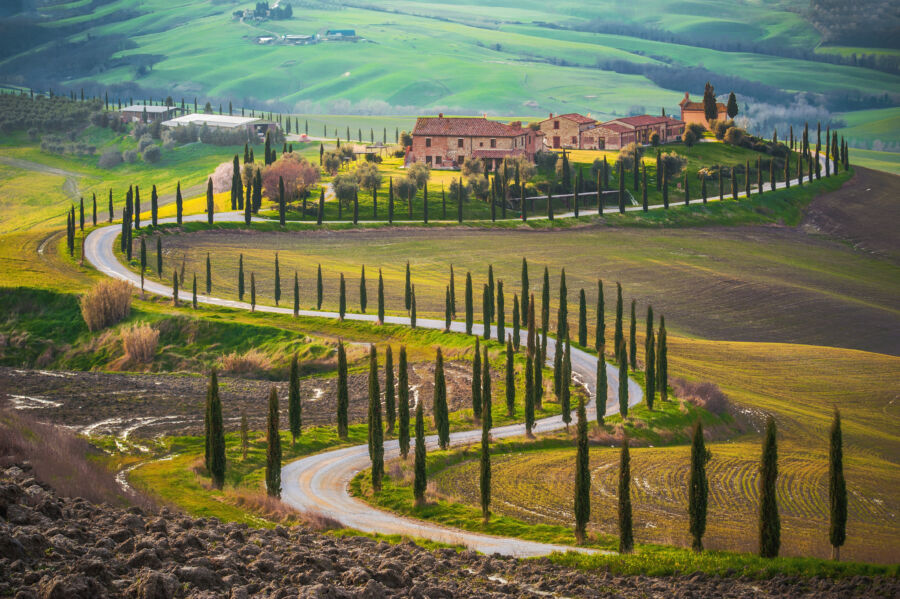
Both Tuscan towns offer amazing chances to explore nature and take scenic walks through historic landscapes dotted with cypress trees and vineyards.
Nature Around Siena

The rolling hills around Siena are perfect for outdoor adventures. The Berignone Nature Reserve has marked trails winding through oak forests and Mediterranean scrub just outside the city.
Hiking paths connect ancient monasteries and medieval villages. The Via Francigena pilgrim route passes right through Siena’s countryside, allowing travelers to walk the same paths they used.
Walking through olive groves and vineyards, you’ll spot local wildlife like pheasants and wild boars. Spring brings colorful wildflowers to the meadows.
Countryside Treks in San Gimignano

San Gimignano’s famous towers rise above a network of scenic countryside paths. The Vernaccia Wine Trail takes you past vineyards growing the town’s famous white wine grapes.
Ancient stone walls line walks between cypress trees and rustic farmhouses. The Sant’Andrea Loop gives amazing views of the medieval towers against the Tuscan hills.
Farm trails connect to neighboring hilltop villages like Certaldo and Montaione. Local agriturismos welcome hikers to rest and taste fresh olive oil or wine.
Many paths are well-marked and suitable for different fitness levels. Spring and fall offer the nicest weather for exploring these historic routes.
See Related: 2 Week Europe Trip Cost: $3,500 Budget Adventure
Accommodation Options

Both Siena and San Gimignano offer unique accommodations that suit different travel styles and budgets. Each town has its charm when picking a place to rest your head.
Staying in Siena

Siena offers a wider range of places to stay, from luxury hotels to budget-friendly spots. The historic center has dozens of beautiful palazzo hotels in centuries-old buildings with modern comforts.
The neighborhoods near Piazza del Campo tend to be pricier but put you right in the middle of everything. Budget travelers can find great deals in the quieter streets outside the city walls.
Many places include stunning views over the Tuscan countryside. Some top picks include converted monasteries and boutique B&Bs tucked into medieval buildings.
Lodgings in San Gimignano

San Gimignano features smaller, more intimate hotels and accommodations scattered throughout its compact medieval streets. The town specializes in family-run guesthouses and cozy agriturismos.
Room rates tend to be lower than in Siena. Many places offer terraces or gardens with views of those famous towers and the rolling hills beyond.
Le Vecchie Mura stands out for its excellent location and panoramic views. Small hotels near the main gates make a perfect base for exploring the town, especially in the quiet evening after day-trippers leave.
The surrounding countryside has charming farmhouse stays where you can experience rural Tuscan life.
Events and Festivals

Both cities host exciting celebrations that bring medieval traditions to life through colorful festivals, historic parades, and lively community gatherings throughout the year.
Siena’s Palio Horse Race
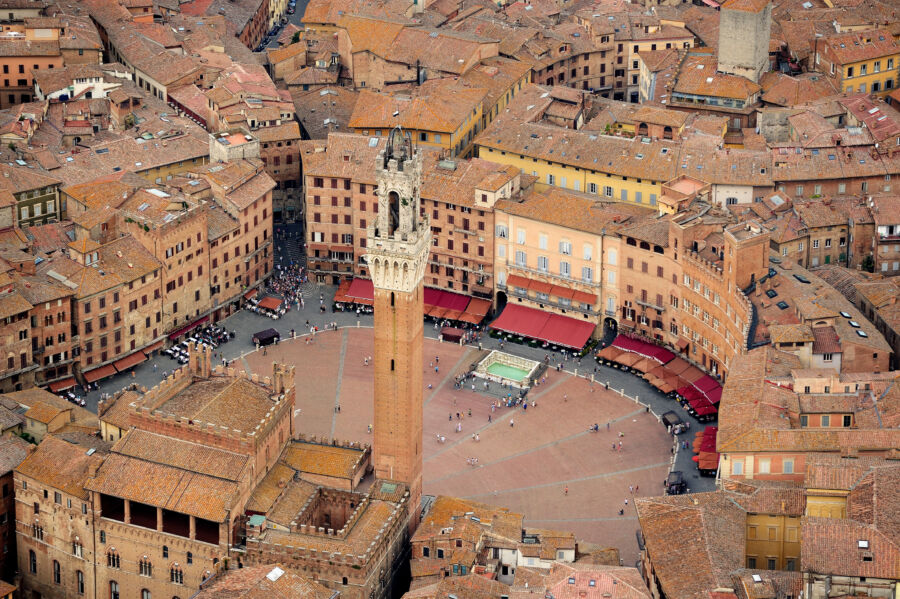
The Palio is a thrilling bareback horse race twice each summer in Siena’s Piazza del Campo. It dates back to medieval times and takes place on July 2 and August 16.
Each race features 10 horses and riders representing different city districts called contrade. The jockeys race three laps around the piazza at breakneck speeds while thousands of spectators cheer.
The excitement builds days before with practice runs, blessing ceremonies, and festive neighborhood dinners. The winning contrada celebrates with massive street parties that last late into the night.
Seasonal Events in San Gimignano

San Gimignano’s calendar fills with medieval-themed festivals that transport visitors back in time. The Ferie delle Messi in June recreates 13th-century harvest celebrations with period costumes and traditional games.
During the Festival of Saint Gimignano in January, locals gather in Piazza del Duomo for the city’s blessing. The square comes alive with market stalls, music, and the ceremonial offering of church candles.
The international arts festival Dentro e Fuori le Mura brings talented performers to unique venues around the medieval towers and city walls. These shows blend historic settings with modern cultural performances.
Many events feature flag-throwing displays, archery contests, and authentic medieval food prepared using ancient recipes. The festivities allow visitors to experience the city’s rich cultural heritage.
See Related: Florence vs Siena: A Local’s Guide to Tuscany’s Most Beautiful Rival Cities
Frequently Asked Questions

Transportation options, time management, and unique experiences shape visitors’ exploration of these two remarkable Tuscan towns. From medieval towers to cultural festivals, each destination offers distinct adventures for travelers.
What are the best transport options for traveling from Siena to San Gimignano?
A rental car gives travelers the most freedom to explore both towns. The drive takes about 45 minutes through scenic Tuscan countryside.
Public buses run between the towns, but schedules are limited. They mainly serve local workers and students rather than tourists.
Organized tours offer convenient transport without parking hassles. Parking can be scarce and expensive in both towns.
How much time should one allocate to visit San Gimignano effectively?
Most visitors need 3-4 hours to explore San Gimignano’s main attractions and medieval towers.
A full day allows time to climb a tower, visit museums, and enjoy a relaxed lunch at local restaurants.
Can a day trip from Florence include Siena and San Gimignano without feeling rushed?
A day trip combining both towns requires careful planning. Start early in Siena, and spend 4-5 hours exploring the city center.
Leave mid-afternoon for San Gimignano. This allows 2-3 hours to see the main sights and medieval towers.
What unique experiences does Siena offer that differ from San Gimignano?
Siena hosts the famous Palio horse race twice each summer in Piazza del Campo. The event draws huge crowds and celebrates centuries-old traditions.
The city’s Gothic cathedral showcases stunning black and white marble stripes. Its intricate floor mosaics tell biblical stories.
When comparing Siena to San Gimignano, what are the key cultural and historical distinctions?
Siena was a major banking center in medieval times. Its architecture reflects this wealthy past through grand palaces and wide piazzas.
San Gimignano earned fame for its tower houses, which noble families built to demonstrate their power and wealth.
Small churches like Sant’Agostino in San Gimignano hide amazing frescoes. Most tourists miss these artistic treasures.
The botanical garden in Siena offers peaceful views and rare plants. The medieval water system, Bottini, runs under the city streets.
Local food shops in both towns sell regional specialties like wild boar salami and white truffles.


